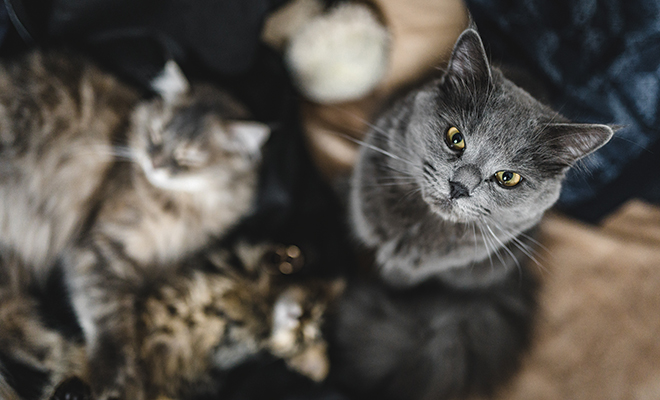
Multi-Cat Households: Tips for Keeping the Peace
Hamilton is a friendly Maine Coon cat who gets along with everyone, including children and dogs. A couple of years ago, Hamilton’s owner, Olivia, brought home two rescue kittens to keep him company. Hamilton was eager to make friends with the newcomers, but the kittens reacted to his overtures with hissing and swatting.
As time passed and the kittens matured, they continued to gang up on the older cat. Today, Olivia has to be careful to keep them separated. She can’t help but feel that Hamilton is puzzled and hurt by their behavior and sometimes wonders if she made a mistake by adding new cats to the household.
If you’re like Olivia and have more than one cat or are thinking about adding another cat to your household, you’re not alone. The American Pet Product Manufacturers Association reports that 71 percent of U.S. cats live in homes with other cats. Feline friendships can be tricky in multi-cat households, but you can lessen the chances of friction and avoid upsetting your resident cats by taking some simple precautions. Here are five ways to encourage cohabitation and avoid inter-cat strife.
Provide ample resources
Cats are territorial by nature, so ask yourself if you really have enough room for another cat. According to the Massachusetts Society for the Prevention of Cruelty to Animals, the more cats you confine in a small space, the greater the chances of misbehavior. Make sure you have vertical spaces for climbing and plenty of scratching surfaces as well as private resting and hiding areas for each cat. Since cats value their personal space, you’ll also need an additional food station and litter box for each feline. In fact, many experts recommend a “number of cats + 1” rule of thumb when it comes to litter boxes.
Start off with a proper introduction
Taking it slowly is essential when it comes to introducing a new cat into the household. Pam Johnson-Bennett, a certified cat behavior specialist and host of Animal Planet’s Psycho Kitty, recommends setting up a separate room for the newcomer that’s equipped with food and water, a litter box and a scratching post. Slowly introduce the new cat to your resident cats and keep them separated until everyone gets comfortable with each other.
Appeal to the feline sense of smell
Many experts suggest the use of natural cat pheromones to help cats get acquainted. Pheromones are scent chemicals released from glands in a cat’s face. Before your new and resident cats have a face-to-face meeting, help them get to know each other by gently rubbing one cat’s face with a clean sock and leaving the sock where the other cat can find it. Repeat the procedure for each cat in your household on a daily basis until the cats become receptive to the socks. Only then should you start the introduction process.
Encourage interactive play
Pent-up energy can lead to aggressive behavior toward both humans and other cats in multi-cat households. Help your cats get plenty of exercise by playing with them and providing a variety of stimulating toys. Cats enjoy toys that satisfy their hunting instinct by mimicking the movements of a bird or mouse. Any small, light object that can be swatted and chased, such as a cork or a ping pong ball, will keep an active cat busy. Most cats also like objects they can explore, such as cardboard boxes and paper bags. In addition to releasing energy, interactive play will allow your cats to bond with each other and with the human members of your household.
Be on the lookout for acts of aggression
Even if you carefully introduce a new cat into your household, one or more of your cats may react with signs of aggression. A cat’s gender doesn’t determine the chances of aggression—female cats can be just as territorial as males. Watch for loud meowing, hissing, growling, swatting and chasing; these actions may be precursors to an actual fight. Consult with a veterinarian if bullying and fighting become a problem, since combative behavior may be masking an underlying health issue. If your cat is healthy, the vet may recommend anti-anxiety medication. Spaying or neutering is also recommended to curb aggression as well as helping to reduce cat overpopulation.
Just like humans, cats have distinct personalities that include individual likes and dislikes. Some cats just need a little time to warm up to a newcomer, while others will continue to defend their turf. An occasional growl or hiss is nothing to worry about, but if one or two cats stalk another (as was the case with Hamilton and the rescue cats), you may have to keep the adversaries separated or find a new home for one of your pets. ■
Sources: catbehaviorassociates.com, hsus.org, mscpa.org and iams.com.







